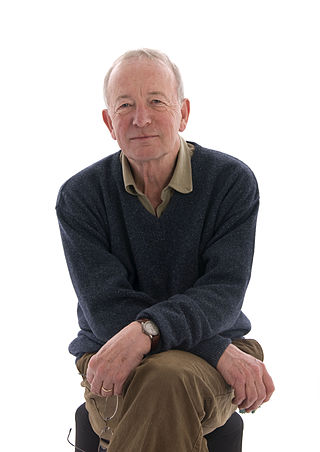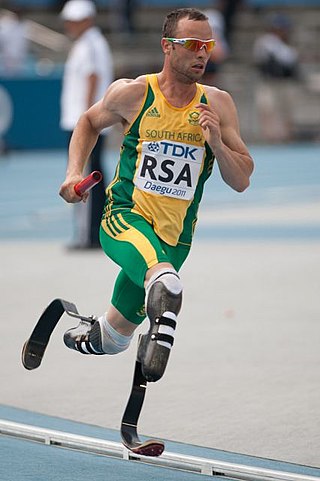
Locked-in syndrome (LIS), also known as pseudocoma, is a condition in which a patient is aware but cannot move or communicate verbally due to complete paralysis of nearly all voluntary muscles in the body except for vertical eye movements and blinking. The individual is conscious and sufficiently intact cognitively to be able to communicate with eye movements. Electroencephalography results are normal in locked-in syndrome. Total locked-in syndrome, or completely locked-in state (CLIS), is a version of locked-in syndrome wherein the eyes are paralyzed as well. Fred Plum and Jerome B. Posner coined the term for this disorder in 1966.

The Man with Two Brains is a 1983 American science fiction black comedy film directed by Carl Reiner and starring Steve Martin and Kathleen Turner.
A vegetative state (VS) or post-coma unresponsiveness (PCU), is a disorder of consciousness in which patients with severe brain damage are in a state of partial arousal rather than true awareness. After four weeks in a vegetative state, the patient is classified as being in a persistent vegetative state (PVS). This diagnosis is classified as a permanent vegetative state some months after a non-traumatic brain injury or one year after a traumatic injury. The term unresponsive wakefulness syndrome may be alternatively used, as "vegetative state" has some negative connotations among the public.

Martín de Porres Velázquez was a Peruvian lay brother of the Dominican Order who was beatified in 1837 by Pope Gregory XVI and canonized in 1962 by Pope John XXIII. He is the patron saint of mixed-race people, barbers, innkeepers, public health workers, all those seeking racial harmony, and animals.
New mysterianism, or commonly just mysterianism, is a philosophical position proposing that the hard problem of consciousness cannot be resolved by humans. The unresolvable problem is how to explain the existence of qualia. In terms of the various schools of philosophy of mind, mysterianism is a form of nonreductive physicalism. Some "mysterians" state their case uncompromisingly ; others believe merely that consciousness is not within the grasp of present human understanding, but may be comprehensible to future advances of science and technology.

Robert Kenneth Ressler was an American FBI agent and author. He played a significant role in the psychological profiling of violent offenders in the 1970s and is often credited with coining the term "serial killer", though the term is a direct translation of the German term Serienmörder coined in 1930 by Berlin investigator Ernst Gennat. After retiring from the FBI, he authored a number of books on serial murders, and often gave lectures on criminology.

Nicholas Keynes Humphrey is an English neuropsychologist based in Cambridge, known for his work on evolution of primate intelligence and consciousness. He studied mountain gorillas with Dian Fossey in Rwanda; he was the first to demonstrate the existence of "blindsight" after brain damage in monkeys; he proposed the theory of the "social function of intellect". He is the only scientist to have edited the literary journal Granta.

A minimally conscious state or MCS is a disorder of consciousness distinct from persistent vegetative state and locked-in syndrome. Unlike persistent vegetative state, patients with MCS have partial preservation of conscious awareness. MCS is a relatively new category of disorders of consciousness. The natural history and longer term outcome of MCS have not yet been thoroughly studied. The prevalence of MCS was estimated to be 9 times of PVS cases, or between 112,000 and 280,000 in the US by year 2000.
g-force induced loss of consciousness is a term generally used in aerospace physiology to describe a loss of consciousness occurring from excessive and sustained g-forces draining blood away from the brain causing cerebral hypoxia. The condition is most likely to affect pilots of high performance fighter and aerobatic aircraft or astronauts but is possible on some extreme amusement park rides. G-LOC incidents have caused fatal accidents in high performance aircraft capable of sustaining high g for extended periods. High-g training for pilots of high performance aircraft or spacecraft often includes ground training for G-LOC in special centrifuges, with some profiles exposing pilots to 9 gs for a sustained period.

A ghost bike is a bicycle roadside memorial, placed where a cyclist has been killed or severely injured, usually by the driver of a motor vehicle.

Oscar Leonard Carl Pistorius is a South African former professional sprinter and convicted murderer. Both of his feet were amputated when he was 11 months old as a result of a congenital defect; he was born missing the outside of both feet and both fibulae. Pistorius ran in both nondisabled sprint events and in sprint events for below-knee amputees. He was the 10th athlete to compete at both the Paralympic Games and Olympic Games.

Ghost Rider is a fictional character appearing in American comic books published by Marvel Comics. He is the third Marvel character to don the identity of Ghost Rider, after Johnny Blaze and the Western hero known as the Phantom Rider, who used the name in 1967.
Disorders of consciousness are medical conditions that inhibit consciousness. Some define disorders of consciousness as any change from complete self-awareness to inhibited or absent self-awareness and arousal. This category generally includes minimally conscious state and persistent vegetative state, but sometimes also includes the less severe locked-in syndrome and more severe but rare chronic coma. Differential diagnosis of these disorders is an active area of biomedical research. Finally, brain death results in an irreversible disruption of consciousness. While other conditions may cause a moderate deterioration or transient interruption of consciousness, they are not included in this category.
Pretoria Central Prison, renamed Kgosi Mampuru II Management Area by former President Jacob Zuma on 13 April 2013 and sometimes referred to as Kgosi Mampuru II Correctional Services is a large prison in central Pretoria, within the City of Tshwane in South Africa. It is operated by the South African Department of Correctional Services.
"The Blood Line" is the tenth and final episode of Torchwood: Miracle Day, the fourth series of the British science fiction television series Torchwood. It was first broadcast in the United States on Starz on 9 September 2011.

The mechanics of the running blades used by South African former Paralympic runner Oscar Pistorius depend on special carbon-fiber-reinforced polymer prosthetics. Pistorius has double below-the-knee amputations and competed in both non-disabled and T44 amputee athletics events. Pistorius's eligibility to run in international non-disabled events is sanctioned by the International Association of Athletics Federations (IAAF).

Reeva Rebecca Steenkamp was a South African model and paralegal. She modelled for FHM magazine and was the first face of Avon cosmetics in South Africa. Steenkamp once worked as the live roaming presenter for FashionTV in South Africa and starred in television advertisements for Toyota Land Cruiser, Clover Industries, Redds and Aldor Pin Pop. She was a celebrity contestant on the BBC Lifestyle show Baking Made Easy in 2012 and on Tropika Island of Treasure season 5 which aired on SABC 3 in February 2013.

The trial of Oscar Pistorius for the murder of Reeva Steenkamp and several gun-related charges in the High Court of South Africa in Pretoria opened on 3 March 2014. Pistorius was a leading South African runner who won attention as an athlete with a disability competing at a high level, including at multiple Paralympic Games and the 2012 Summer Olympics. Steenkamp, a model, had been Pistorius's girlfriend for three months. In the early morning of Thursday, 14 February 2013, Steenkamp was shot and killed by Pistorius at his Pretoria home. Pistorius acknowledged that he shot Steenkamp, but he said that he mistook her for an intruder. Pistorius was taken into police custody and was formally charged with murder in a Pretoria court on 15 February 2013. The entire trial was broadcast live via audio, and parts of the trial were also broadcast live via television.
The attention schema theory (AST) of consciousness is a neuroscientific and evolutionary theory of consciousness which was developed by neuroscientist Michael Graziano at Princeton University. It proposes that brains construct subjective awareness as a schematic model of the process of attention. The theory is a materialist theory of consciousness. It shares similarities with the illusionist ideas of philosophers like Daniel Dennett, Patricia Churchland, and Keith Frankish.











